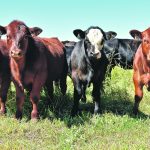Seven-way or eight-way clostridial vaccines considered producers’ best options when controlling this family of diseases
Blackleg, redwater, malignant edema and several types of clostridium perfringens can affect calves, which is why most ranchers vaccinate with a seven-way or eight-way clostridial vaccine. “This is probably the most widely used vaccine. If people don’t vaccinate against these diseases, eventually they will lose cattle,” says Dr. John Campbell of the Western College of […] Read moreStories by Heather Smith Thomas

Grass-finished beef all about forage

Winged predators a threat to cattle

Uterine infection significant risk after calving

Going slow speeds handling process
An Alberta rancher says cattle are better behaved if they can walk into a corral calmly and quietly instead of being chased
Dylan Biggs recognized the benefits of quiet cattle handling early in his career. The Hanna, Alta., rancher learned from Bud Williams, who spent many years in Alberta practising and teaching low-stress methods for moving and sorting cattle. “The first thing that sets the stage for good handling in a corral is how the cattle were […] Read more
Portable corrals ease handling stress
Facilities can be set up anywhere, even in the middle of a large pasture, but it’s important to handle the cattle properly
Portable corrals can make handling easier when cattle are in large pastures. Dr. Kip Lukasiewicz of Sandhills Cattle Consultants says his early experience with portable corrals occurred when he was in a cow-calf practice at Ainsworth, Nebraska. “We did a lot of pregnancy checking, Bangs vaccinations, etc. with more than 45,000 cows in that practice. […] Read more
Horned cattle may require special chutes
Horns are an asset in the Longhorn, Watusi and Scotch Highlander breeds, but safe handling methods must be found
The handling of horned cattle requires special considerations. Longhorn, Watusi and Scotch Highlander breeds, as well as yaks, can have horns that aren’t easily accommodated in regular cattle chutes. Thus, there are specially designed chutes that are safer for the animals and the people handling them. They include simple panels with horizontal bars so the […] Read more
Handling and sorting can be easy, with or without a corral
Patience, an ability to read cattle and knowing the pastures and terrain can make all the difference when handling cattle
Cattle respond to good handling by becoming easy to manage. If mishandled, they react with suspicion or fear when they see people and become difficult to handle. Consistent, non-confrontational methods can build trust in a herd. Al Fenton of Fenton Herefords near Irma, Alta., has been raising Herefords for decades and has 700 registered cows, […] Read more
Breeder urges producers to reap benefits of hybrid vigour
Montana producer says Charolais has the most potential for crossing because many other European breeds have changed
Crossbred cattle have several advantages over purebreds, especially fertility, longevity, feed efficiency and disease resistance. Buddy Westphal, a Charolais breeder near Polson, Montana, says he is amazed that more ranchers haven’t taken advantage of hybrid vigour. “When I was in college 50 years ago, that was the ‘new’ thing that got me into the Charolais […] Read more
Producers find sweet spot when catching calves
Developing a good relationship with all members of the herd can help ranchers minimize stress for calves and themselves
Ideally, sick calves are detected early and treated. A weak, listless calf is easy to catch but what about the ones with mild illness that can evade capture? Some ranchers think that a hard-to-catch calf isn’t sick enough to treat. However, a lethargic calf likely means intervention was required sooner. It can be challenging to […] Read more



